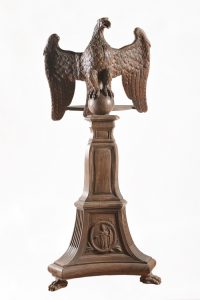
Anonymous
France
18th century
Polished wood
Deposit from the Saint-Martin church, Vez, 1973
Registered as a Historical Monument
Inv. D1973.4.1
______________
This eagle lectern is a deposit from the Vez commune in 1973, for the exhibition “Treasures of the Valois”.
Contrary to transportable lecterns which are dedicated to reading the Gospels in public, the stationary lectern is meant to hold choir books. Its function is similar to that of a cloth-covered lectern or an ambo. Documented in France as early as the 7th century, it was used by copyists during religious ceremonies but also by the very few owners of books destined for personal use.
On many lecterns used for religious purposes, the open book shows a representation of Saint John’s eagle recalling the Gospels, which explains why they are called eagle lecterns. This eagle, figure of the closest apostle to Jesus, is the sign of the battle between good and evil, the contemplation of eternal realities and the symbol of tolerance. It also carries the image of speed and the spreading of the divine word. The eagle holds a globe in his claws, the emblem of the universal sovereignty of Christian faith.
The three feet recall the trinity and are represented as animal paws, this time symbolizing the lion, Saint Marc’s animal and referring to resurrection and the power of faith.
On the lectern of the Saint-Martin church in Vez, three medallions of archbishops are present on the three sides of the base.